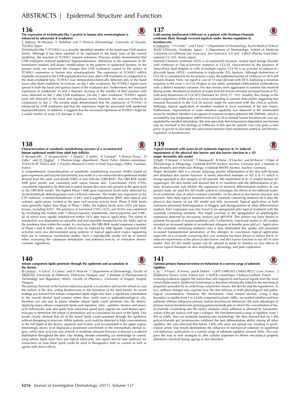Characterization of Xenobiotic Metabolizing Enzymes of a Reconstructed Human Epidermal Model from Adult Hair Follicles
September 2017
in “
The journal of investigative dermatology/Journal of investigative dermatology
”
reconstructed human epidermal model outer root sheath hair follicles xenobiotic metabolizing enzymes cytochromes P450 CYPs alcohol dehydrogenases aldehyde dehydrogenases carboxyl esterases Phase I XME genes Phase II XMEs GSTs transferases CYP inducers 3-methylcholanthrene beta-naphthoflavone UGTs SULTs 7-ethoxycoumarin testosterone benzo(a)pyrene AhR ligands reconstructed skin model ORS-RHE hair follicle model xenobiotic enzymes CYP enzymes alcohol enzymes aldehyde enzymes esterases Phase I enzymes Phase II enzymes glutathione S-transferases 3-MC BNF UGT enzymes SULT enzymes

TLDR The reconstructed skin model from hair follicles functions like human skin in processing chemicals and can be used to test ingredient safety.
The document presents a study on a reconstructed skin epidermal model derived from the outer root sheath of hair follicles (ORS-RHE), which was used to characterize xenobiotic metabolizing enzymes (XMEs). The gene expression profile of XMEs in the ORS-RHE model was consistent with that of native human skin, including the presence of cytochromes P450 (CYPs). The model showed high expression levels of Phase I XME genes, particularly alcohol/aldehyde dehydrogenases and (carboxyl) esterases, and even higher levels of Phase II XMEs, with GSTs and transferases being the most prominent. The model responded to CYP inducers, such as 3-methylcholanthrene (3-MC) and beta-naphthoflavone (BNF), both topically and systemically, with increased gene expression and enzyme activity. Functional activities of CYPs, UGTs, and SULTs were confirmed by the rapid metabolism of substances like 7-ethoxycoumarin, testosterone, benzo(a)pyrene, and 3-MC within 24 hours of topical application. The extent of metabolism was influenced by the enzymes' saturation and the residence time within the model. The study concluded that the ORS-RHE model expresses functional Phase I and II XMEs, some of which can be induced by AhR ligands, making it a valuable tool for evaluating the metabolism and potential toxicity of dermo-cosmetic ingredients.
